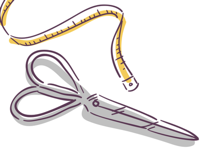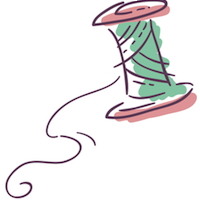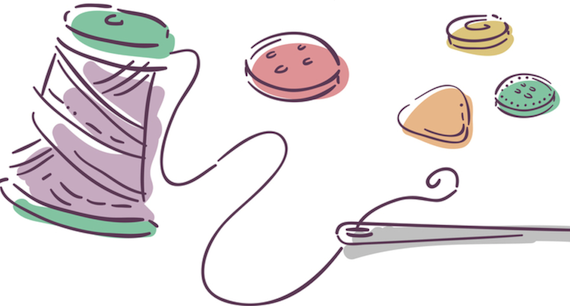The Common Thread for Co-Teaching Success
A MiddleWeb Blog
Think about your vision of an ideal co-teaching experience. What is it that makes that work? What’s happening in the classroom? What is each teacher doing? What are the students doing?
What do you think the magic ingredient is that makes this ideal partnership work? I’m going to take a chance and read your minds here…
This ideal partnership works because teachers:
- have administrative support.
- have both volunteered to co-teach.
- have common planning time.
- have worked together for years and can now read each other’s minds and finish one another’s sentences!

And teachers must work professionally together to make instruction accessible for variable learners whether they are working together for the first time or the hundredth time.
And the reality is that co-teaching partnerships change all the time. So it can’t just be those reasons mentioned above. We must continue to find a common thread to make co-teaching success the norm. Hey, it’s possible!
Over the past years, I have experienced a variety of views of what co-teaching looks like. I’ve seen (and read, and heard about) it all—the good, the bad, and the really ugly! For so long now I’ve been on a mission to find a common thread that could be the solution to making co-teaching work regardless of the situation.
And I think I found it! Seriously—no kidding! All it takes is for the special education teacher to go back to his roots. Get back to the essence of his expertise. Any ideas? Not sure what I’m thinking yet? Then keep reading!
Some Clues and Anecdotes
I’ve experienced co-teaching at the elementary (grades K-5) and the middle school level (grades 6-8). As a result of my transition from elementary to middle school settings, I realized the missing link that all truly successful co-teaching experiences need. In the upper grades co-teaching becomes a bit more challenging because the content comes on fast and furious. The balance is easily lost—with the weight tipped heavily on the side of teaching the content.
And I’m afraid that many teachers forget they are teaching individual human beings—not subject matter. Then add on the pressure many teachers feel about test scores that have a say about their own evaluations (don’t even get me started on that topic! At least not now).

Personally, I’ve had many awkward conversations with general education teachers who just wanted me to go along with their plan—their way. And why? Because that’s the way they have always done it—and it has always worked. For some. Sigh.
So how do we find the balance? Have you thought about that missing link I mentioned earlier that can create successful co-teaching experiences regardless of the situation? OK, OK, here it is…
Enter Specially Designed Instruction…
According to IDEA, specialized instruction involves adaptations to the content, methodologies, or delivery of instruction that meet the unique needs of each child as a result of a disability. Specially designed instruction must accommodate each child’s needs, so he has access to the general education curriculum, and he can have the opportunity to meet the same high standards as his same-aged peers. Is this happening in our co-teaching classrooms? Look around—what do you think?
Here’s what must happen…
Special education teachers and general education teachers must respect the individual expertise that each brings to the classroom. The special education teacher must advocate for each student with a disability by asking:
- What makes this student different from other learners?
- What can I do differently for this student to ensure access to the general education curriculum?
SDI is all about making sure that in the moments of class—right there during the same instruction that everyone receives—each student’s needs are met. Instruction must be adapted in some way to provide something different—something specialized—something to provide a clear pathway for students to access the opportunities to learn. (Be sure to check out how to implement Universal Design for Learning to strengthen your specialized instruction planning process within a general education setting. See my recent post on 5 Steps We Can Take to Accommodate the Core.)
An SDI Example
Here’s SDI in action for students who need support with working memory. Without support and scaffolds (that’s SDI) during the moments of instruction these students would be lost. They would be sitting in class for nothing. They would be passive listening posts and would just forget all information from the 40-minute content storm of the typical classroom. The special education teacher must step up and share some SDI love.
Here’s what teachers can do:
| Specialized Instruction | Accommodation |
| Direct/Explicit instruction | Visual Cues |
| Teach Self-Monitoring Skills | Break down Information/Assignments |
| Teach Note-Taking Strategies | Use Color Coding |
| Teach Metacognitive strategies | Use of timer |

Specially Designed Instruction, supported by the Universal Design for Learning strategies, must become the common thread that makes co-teaching experiences work for both teachers and all students. It just makes sense.
Do you think that if every special education teacher advocated in their co-teaching classrooms in this way then co-teaching instruction would have a greater chance of being successful – regardless of the co-teacher pairings? Let’s talk!





































Thank you for your article! As someone who is dedicated to co-teaching in my practice, research, and publication, I concur with your thoughts. There are so many issues I see with co-teaching but one of the major ones is a lack of true differentiation. The whole point of co-teaching is to ensure that students – all students- are getting what they need in a co-taught general education setting. Two teachers simply doing what one would have done is insufficient. Dr. Sally Spencer and I identified the essential question of co-teaching as this “How is what two teachers are doing together substantively different and better for students than what one teacher would do alone? ” (Murawski & Spencer, 2011, p. 96). Thank you for again bringing this to the forefront of this issue. :)
This is such a helpful article! As you note, there are so many classrooms where co-teachers are simply replicating what the other is able to do, rather than delivering specialized instruction. Specially designed instruction, supported by UDL, can truly support students within our classes. Perhaps it is because we, as special educators, must be better advocates for our roles and our students. I will be sharing this with many of our co-teachers as well as our instructional coaches. Thank you!
Christie, so great to see how our virtual paths continue to connect across virtual settings! I must let our readers know, Christie is one of my co-moderators (extraordinaire!) for our bi-monthly Twitter chat all about co-teaching! Use the hashtag #coteachat every 2nd and 4th Tuesday at 8:00 ET. Join us!
Christie, I’m so glad that this post resonates in a way that will be useful to you and your colleagues. Please come back and share how your colleagues connect and extend the ideas in this post.
Yes! we must be the best advocates humanly possible to support our roles as facilitators of learning. We must provide our students with the skills they need to be as independent (and successful) as possible! Many thanks and enjoy!
Dr. Murawski, thank you for sharing your insights! I encourage our readers to visit your website: http://www.2teachllc.com/ for more details about the great work that you do! Thanks again for adding your voice–I hope you will come back often to share your thoughts throughout the year! All the best!
I enjoyed reading your article. I am a special education teacher and also co-teach in a second grade room with a general education teacher. We look at our co-teaching classroom as a marriage. Somethings work and somethings do not. We have to learn from our mistakes and see how we can make it better next time. When planning we both sit down and look at the objectives and activities for the day and/or week. We are constantly working on making the curriculum accessible to all students including students with/without IEPs.
I enjoyed reading this article because I have had experience co-teaching in a therapeutic day school as an assistant special educator. One point of this article that stood out to me was that regardless of our similarities or differences, all teachers have to work together to provide successful instruction for all students. When I first began as an Assistant teacher, I was introduced to a new classroom with all new students. The classroom teacher did not seem very supportive at the beginning and almost seemed frustrated to have to train me on all of the students. We both had very different teaching styles and often disagree on ideas for lesson or behavioral plans. I found it very difficult to express myself and remain confident when my direct supervisor and colleague did not respect my input or ideas. I believe that if we both were trained in SDI, we would have been more prepared for sharing instruction and found common ground. However, there has been progress with time and we are able to share our reflections and ideas with open minds. This article did bring to light the difficulties that special education teachers in a general education setting may face when collaborating with their colleagues, and I believe this article offers great tools to balance the co-teaching model.